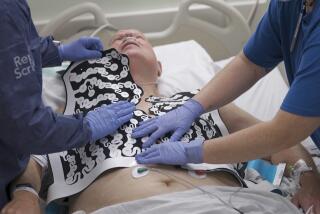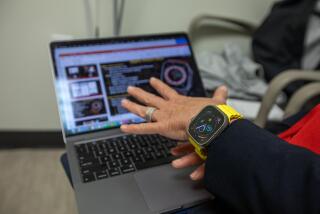Beating back arrhythmia
- Share via
Until last winter, Joseph Moniz, 50, a Massachusetts man with congestive heart failure, was waiting, like 4,000 other Americans, for a heart transplant to save his life. He never got it. But he got something better -- a small device called an implantable cardioverter defibrillator.
The gadget, like the one Dick Cheney got, is familiar but with a twist. Like older defibrillators, Moniz’s device can shock his heart back to normal if the lower chambers, or ventricles, start beating in a rapid, life-threatening rhythm. This kind of arrhythmia, called ventricular fibrillation, causes 350,000 sudden deaths every year.
But the new device can also do something else -- resynchronize the beating of the ventricles so that they work efficiently. This is a potentially huge boon for many of the 5 million Americans with congestive heart failure, a condition in which the heart beats inefficiently and fluid accumulates in tissues. Other heart patients, at a handful of medical centers around the country, are getting a variety of other treatments for the electrical problems in their hearts.
For decades, cardiology was ruled by medical plumbers, doctors who fixed crucial coronary arteries that had become clogged with cholesterol. But now, a new batch of cardiac gurus is in the limelight -- the cardiac electricians, or more precisely, the electrophysiologists.
In the heart, the electrical signals that control rhythms originate in a built-in pacemaker, the sinoatrial node, a small bit of tissue at the top of the right atrium. Normally, the sinoatrial node produces about 60 heartbeats a minute. The electrical signal spreads through the right and left atrium, then activates the atrioventricular node, a relay point between the upper and lower chambers. From there, the electrical signal spreads through the ventricles. After the ventricles contract, the signal dies out and the heart waits for a new signal from the sinoatrial node.
When these electrical signals become deranged, cardiac havoc can occur, including atrial and ventricular fibrillations, in both of which the heart beats wildly and very rapidly. Such arrhythmias “are becoming an epidemic” because the risk goes up with age and the population is aging, says Dr. Valentin Fuster, director of the Cardiovascular Institute and Health Center at Mt. Sinai Medical Center in N.Y.
But treatments often help. Last March, the New England Journal of Medicine published a major study called MADIT II that was stopped early because the results were so clear. It involved more than 1,200 patients and showed that those randomly assigned to get standard ICDs to shock their hearts back into normal rhythm when ventricular arrhythmias occurred had a 31% decreased risk of death compared with those receiving standard drug (non-ICD) therapy.
Roughly 1 million Americans have heart attacks every year, and more than a third wind up with poor ventricular function as a result. The new generation of ICDs not only can shock the heart back to normal rhythm but can synchronize the coordination of the ventricles by way of an extra wire, or lead, that runs from a pacemaker in the chest to the left ventricle, the main pumping chamber of the heart.
Some congestive heart failure patients now getting resynchronizing ICDs are “feeling so well with ventricular resynchronization that they no longer need a heart transplant,” says Dr. Lynne Warner Stevenson, co-director of the cardiomyopathy and heart failure program at Brigham and Women’s Hospital.
Just as ever-improving ICDs are transforming care for patients with ventricular arrhythmias, so too is catheter ablation improving care for Americans with atrial fibrillation, a problem that strikes more than 2 million.
In “A Fib,” electrical signals in the heart’s upper chambers, or atria, cause the heart muscle to flutter wildly, which in turn reduces the efficiency of the ventricles. This allows blood to pool and form clots that can lead to strokes. In a recent study published in the New England Journal of Medicine, researchers found that for older patients who were at risk of stroke from atrial fibrillation, treatments to control heart rhythm were no better at preventing death than treatments to control heart rate.
But other data suggest that for people whose main concern is disruption of quality of life because of “A Fib,” catheter ablation may provide substantial relief.
In this treatment, electrophysiologists place catheters, or tubes, into the heart and use them to send use radio waves to burn away specific, tiny areas, particularly those on veins going from the lungs to the heart, that trigger arrhythmias.
“Until a year or two ago, no one ever thought you could use catheters to approach this problem,” says Dr. Kalyanam Shivkumar, director of interventional cardiac electrophysiology at the David Geffen School of Medicine at UCLA. Now, says Dr. Davendra Mehta, director of the cardiac electrophysiological lab at Mt. Sinai Medical Center in New York, the technique could become for some patients “the treatment of choice.” Researchers are also experimenting with destroying electrically dangerous tissue with ultrasound, microwaves and cryogenic techniques.
There is still, as many doctors warn, a long way to go before all arrhythmias can be controlled. But, says Dr. Jeremy Ruskin, director of Cardiac Arrhythmia Service at Massachusetts General Hospital: It’s “a very exciting area -- there’s a tremendous amount happening.”
Nobody needs to tell that to Joseph Moniz. Now off the heart transplant list, Moniz is doing things he thought he’d never do again. “I washed my truck for the first time in a couple of years,” Moniz says. He still can’t work, but says, “I feel excellent.”
Judy Foreman is a lecturer on medicine at Harvard Medical School.






